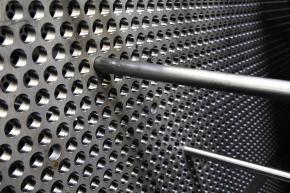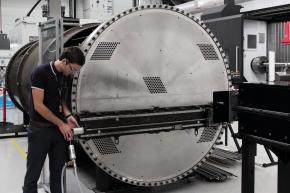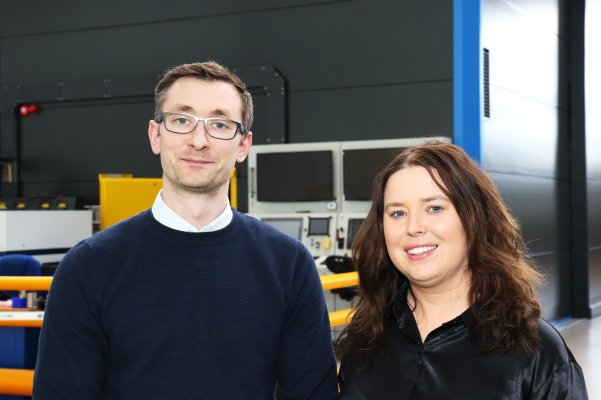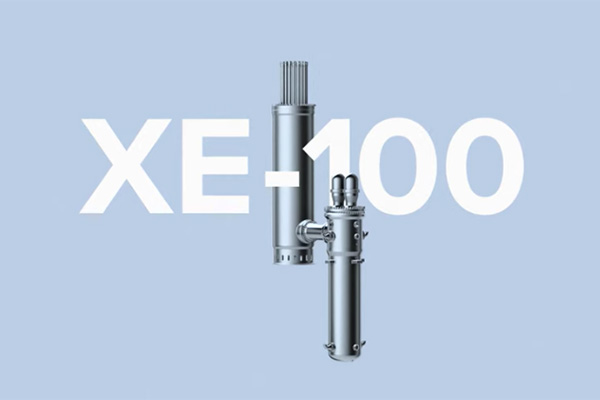The Nuclear AMRC has worked alongside Rolls-Royce to significantly reduce the time needed to produce a complex heat exchanger sub-assembly.
 The project focused on a baffle cage, a complex and precise arrangement of 5,000 six-metre tubes, all of which must be inserted through 11 plates and then expanded and welded into position.
The project focused on a baffle cage, a complex and precise arrangement of 5,000 six-metre tubes, all of which must be inserted through 11 plates and then expanded and welded into position.
“Traditional approaches to building baffle cage assemblies, which make up about 20 per cent of a heat exchanger, rely on manual alignment of the baffle plates,” explains Hugo Lobato, technical programme manager in Rolls-Royce’s new build and nuclear projects team. “We have replaced the manual approach with the introduction of laser tracking to build in a much higher degree of accuracy when inserting the tubes.”
The team used the Nuclear AMRC’s Leica laser tracking system to create a real-time model of the whole assembly, allowing the position of each plate to be precisely mapped. The process was developed on a full-size assembly in the Nuclear AMRC’s workshop.
The centre’s engineers procured or manufactured all parts of the test assembly, and provided engineering support to develop assembly instructions and risk assessments. The team also worked with specialist design engineers at the Nuclear AMRC’s sister centre, the AMRC with Boeing, to create new assembly fixturing and devices to improve safety for the workers loading and positioning the plates.
![]() “We have developed and demonstrated an innovative in-process measurement technique which ensured that the plates were properly aligned, using advanced metrology techniques including laser tracking and optical metrology,” says Dave Stoddart, project manager at the Nuclear AMRC. “These techniques are widely used in the aerospace sector, but are not commonly found in the manufacture of heat exchangers.”
“We have developed and demonstrated an innovative in-process measurement technique which ensured that the plates were properly aligned, using advanced metrology techniques including laser tracking and optical metrology,” says Dave Stoddart, project manager at the Nuclear AMRC. “These techniques are widely used in the aerospace sector, but are not commonly found in the manufacture of heat exchangers.”
The baffle cage project will help Rolls-Royce achieve its strategic target of reducing its domestic civil new build manufacturing and engineering costs by around half.
“Using this method, we are confident we can consistently cut by half the time needed for the process,” says Lobato. “Furthermore, ensuring that tube placement is right first time further reduces delays and eliminates the potential for re-work and the cost associated with it. This yields predictable and consistent lead times, which is of great benefit to Rolls-Royce because it enhances the level of service we are able to deliver to our customer.
“As a result of this work, which has had the highest focus on quality, we are able to confidently deliver to our customer a product that is right first time and within a much shorter lead-time. This outcome has only been achievable through innovative thinking and the application of state-of-the-art measuring tools and techniques.”
The project has shown that time savings well beyond Rolls-Royce’s original target can be achieved, says Nuclear AMRC projects director Alan McLelland. “Using these principles, we could reduce assembly time by up to 80 per cent across a range of heat exchanger assemblies,” he notes.
The project was part of the civil nuclear Sharing in Growth programme, which aims to develop the UK manufacturing supply chain for the global civil nuclear market. The programme is part-funded by government through the Regional Growth Fund, and led by the Nuclear AMRC with support from Rolls-Royce and other industry leaders. As well as industry-led research and development, CNSIG includes intense business development for 10 key suppliers.
 The team is continuing to investigate innovative ways to improve the manufacturing process, including improved techniques to weld heat exchanger tubes to tubesheets, and the use of portable machine tools to produce features on the assembly’s end plates.
The team is continuing to investigate innovative ways to improve the manufacturing process, including improved techniques to weld heat exchanger tubes to tubesheets, and the use of portable machine tools to produce features on the assembly’s end plates.
“These machines are generally used in the oil and gas sector for in-situ repair and are not usually associated with the manufacture of new components,” explains Stoddart. “The research challenge is to ensure that nuclear industry health and safety requirements are met, while achieving a reasonable level of productivity which current portable machines are not designed to achieve.”




